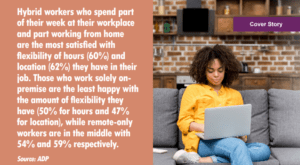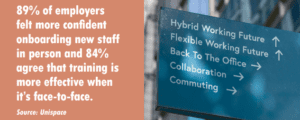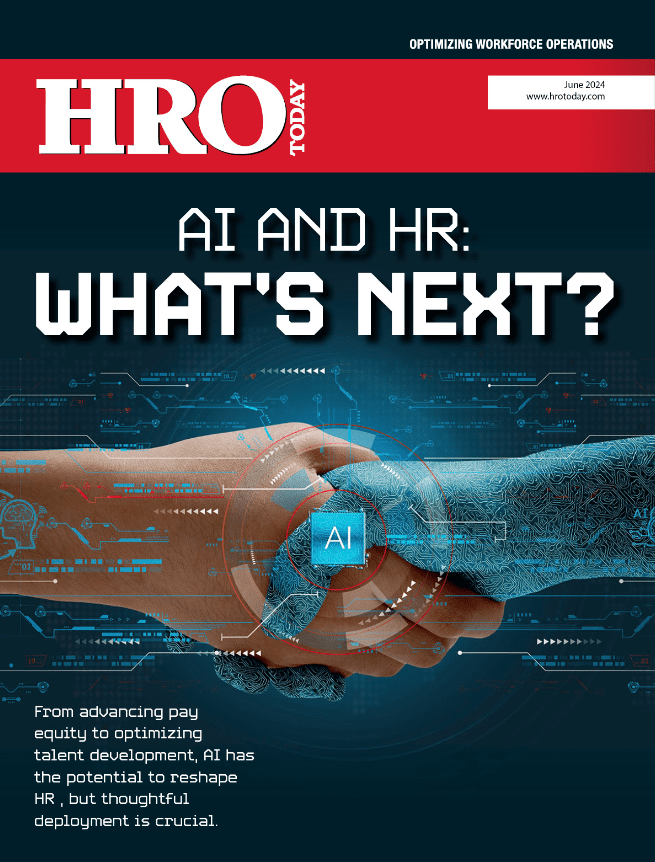Return to office or remote, HR leaders are still figuring out the approach to work that works best for them.
By Simon Kent
Three years after organisations were forced to adopt working from home and flexible work practices, some well-known names are hitting the headlines for insisting their employees return to the office. Through incentives, persuasion, or even penalties, the era of flexible work may
be over.
According to a study from global workplace design company Unispace, the dispersed workplace still presents challenges for employers. Its research found 89% of employers felt more confident onboarding new staff in person, and 84% agree that training is more effective when
it’s face-to-face. Four in 10 employers suggested that new hires have taken longer to get to the required level expected of them in a virtual environment.
The study suggests that both employers and their staff are yearning for the days when these processes were carried out on a face-to-face basis,” says Julie Lecoq, workplace strategist and change management specialist at Unispace. “This is a problem that businesses will find exceptionally hard to overcome as it is impossible to replicate the value gained from being in the office while being physically disconnected from colleagues.”
While Lecoq doesn’t believe mandating people is the answer to bringing employees back, she does think that certain parts of a worker’s employment experience—particularly for new hires—should be office-based.
Aurum Solutions is leveraging its culture to encourage employees to return to the office. According to Dave Anfield, chief operations officer, the business is working to build a culture where people want to be together, spend time together, and genuinely care about each other. Through this, he argues, the quality of work will improve.
Despite the effectiveness of work across hybrid and flexible structures, Anfield says, “The benefits of organic collaboration on troubleshooting, improvements, and overall team building and working together are incredibly powerful.”
Motivating people back to the office has not been a question of laying down new laws, but of creating a culture where working in the office is desirable. “Incentives include regular company-wide social events, breakfast Mondays, well-being Wednesdays, and drinks/pizza Thursdays,” says Anfield. “Aurum’s offices sit within a wider shared working environment complex, so we can bring all of our teams together in a traditional dedicated office space alongside the buzz and feel of a broader entrepreneurial and social community.”
Anfield also notes that within this scenario, employees can experience the benefits of being together, which in turn fosters further in-office work. He lists spontaneous collaboration, idea sharing, and the potential to contribute to their professional development as benefits of being in one single official location. “The team and I know the importance of offering an exciting and cooperative office culture that boasts inclusivity and the enthusiasm for everyone to succeed,” he says. “No department is closed off to another, and everyone genuinely cares about and celebrates the successes of their coworkers. As the company continues to grow, we are working hard to maintain the inclusive factor and capitalise on the benefits of in-office working.”
Aurum’s approach clearly takes into account the circumstances of each employee. And Bev Cunningham, chief people office for Ricoh Europe, also notes that in-person work may not be suitable for all—especially for those who are dealing with illness or caring responsibilities.
“When offering hybrid arrangements to employees, businesses need to be equipped with the right tools and equipment to ensure the transition between remote and office working throughout the week is as seamless as possible,” she notes.
Ricoh have developed their own “RICOH Spaces” technology to manage hybrid working, which enables the business to manage their office spaces efficiently, ensuring employees have a dedicated workspace when they choose to come in.
“We don’t believe that you should ‘demand’ an employee to work from a specific location, especially if the work can be carried out from outside the office environment,” Cunningham says. “Flexibility and accommodating employee preferences are a core part of our values.”
Cunningham admits that COVID-19 challenged the perception of the office and the various benefits that came along with it. She is also clear that while working remotely is beneficial, face-to-face interaction still plays a vital role within the hybrid working model. “The office is a space
for people to collaborate, and our office environment provides these opportunities for personal interactions and developing deeper connections amongst teams,” she says.
“I’ve found that giving employees the power of choice is the true foundation of flexible working,” says Gareth Hoyle, managing director of SEO specialists Marketing Signals. “When the time is right, members of the team who would prefer to work in the office will be able to do so, while those who work best at home will be allowed to remain there indefinitely. Implementing a blanket rule for all employees will never offer true flexibility and will only damage your relationship with your employees and the trust you’ve built.”
Hoyle says he trusts his employees to find the right working balance for themselves. As a result, so far, neither productivity nor morale has suffered. “This also builds trust,” he adds. “My team knows that as long as they’re doing the work, I don’t mind where they complete it.”
Flexible working remains a possibility for all workers. Leslie Tarnacki, chief HR officer at WorkForce Software, believes technology can bring the right balance to a wide range of workers. “Fortunately, employers can utilise modern workforce management technologies to provide frontline workers with more control over their own schedules, allowing them to coordinate shifts around personal or work obligations, submit time-off requests, and gain access to real-time shift swapping,” she remarks. “This level of flexibility for frontline staff, as well as those in headquarters, will be a competitive differentiator in today’s war for talent.”
















